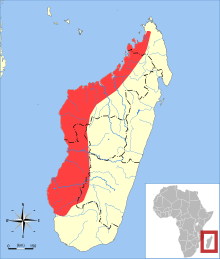Chaerephon jobimena
Chaerephon jobimena, commonly known as the black and red free-tailed bat,[1] is a species of bat in the family Molossidae. It is endemic to western Madagascar.[1] With a forearm length of 45 to 48 mm (1.8 to 1.9 in),[2] C. jobimena is somewhat larger than other Malagasy bats assigned to Chaerephon, but similar in size to Tadarida aegyptiaca (see below).
| Black and red free-tailed bat | |
|---|---|
| Scientific classification | |
| Kingdom: | Animalia |
| Phylum: | Chordata |
| Class: | Mammalia |
| Order: | Chiroptera |
| Family: | Molossidae |
| Genus: | Chaerephon |
| Species: | C. jobimena |
| Binomial name | |
| Chaerephon jobimena | |
 | |
| Range | |
| Synonyms | |
|
Tadarida jobimena (Goodman & Cardiff, 2004) | |
Habitat
The known habitats of the species are tropical dry deciduous forest and spiny forest at altitudes from 50 to 870 m. It roosts in trees as well as in houses and other buildings, but has not been found to commonly roost in caves.[1]
Taxonomy
Although currently listed as a member of the genus Chaerephon, whose members it resembles morphologically, C. jobimena's closest relatives based on molecular evidence are Tadarida aegyptiaca of Africa and southwest Asia, and Tadarida brasiliensis of the Americas, which form a clade believed to be about 9.8 million years old. C. jobimena and T. aegyptiaca were found to be sister species.[3] The morphological resemblance thus apparently represents parallel or convergent evolution. While sequence data indicates that Chaerephon, Mops and Tadarida are not monophyletic taxa, the grouping of Chaerephon minus C. jobimena plus Mops was found to be monophyletic.[3]
Conservation status
Although the species is not common, it has an extensive range that includes the vicinity of four protected areas, and is not believed to be dependent on undisturbed forest habitat. For these reasons, it has been categorized as being of 'least concern' by the IUCN. Subsistence hunting may be a threat in southern Madagascar.[1]
See also
References
- Monadjem, A.; Razafimanahaka, J.; Ranivo, J.; Kofoky, A.; Hutson, A.M.; Cardiff, S.G.; Andriafidison, D.; Goodman, S.; Jenkins, R.K.B.; Racey, P.A.; Ratrimomanarivo, F.H. (2017). "Chaerephon jobimena". IUCN Red List of Threatened Species. 2017: e.T136393A22014976. doi:10.2305/IUCN.UK.2017-2.RLTS.T136393A22014976.en. Retrieved 24 December 2019.
- Goodman, S. M.; Cardiff, S. G. (December 2004). "A New Species of Chaerephon (Molossidae) from Madagascar with Notes on Other Members of the Family". Acta Chiropterologica. 6 (2): 227–248. doi:10.3161/001.006.0204.
- Lamb, J. M.; Ralph, T. M. C.; Naidoo, T.; Taylor, P. J.; Ratrimomanarivo, F.; Stanley, W. T.; Goodman, S. M. (June 2011). "Toward a Molecular Phylogeny for the Molossidae (Chiroptera) of the Afro-Malagasy Region". Acta Chiropterologica. 13 (1): 1–16. doi:10.3161/150811011X578589.
